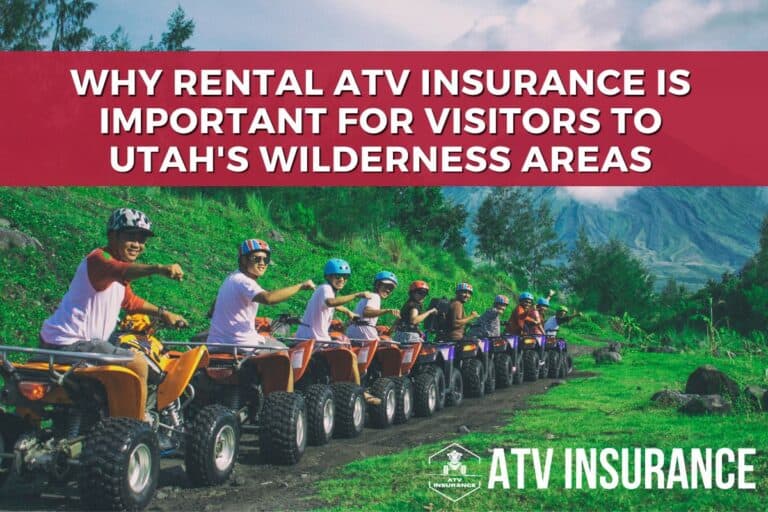ATV usage in Utah has risen dramatically over the past decade, with a recent study finding that there are now nearly 15,000 registered ATVs on public land.
This rise in use has led to an increased need for greater regulation of these vehicles and their effects on both public and private lands.
The aim of this article is to assess the impact of ATV insurance on existing land-use regulations in Utah, exploring how it can help protect property owners from potential losses associated with off-road activity.
Through analysis of current policy trends and relevant case studies, this paper will examine how insurance can be used as an effective tool for mitigating risk when using all-terrain vehicles (ATVs).
The Importance Of Complying With Regulations To Protect Public Lands And Trails
The protection of public lands and trails is paramount to preserving the environment. The enforcement of land-use regulations is essential in protecting wildlife, ecosystems, and rural communities from recreational activities that can lead to negative impacts on these areas.
This includes off-road vehicle use, such as All Terrain Vehicles (ATV), which, when used irresponsibly, can damage lands around them by creating dust clouds, causing erosion, and leaving behind litter.
In Utah specifically, where ATVs have become increasingly popular for recreation, the Bureau of Land Management has sought to enforce guidelines regarding their responsible operation and minimize potential environmental damage caused by irresponsible riders. Such measures include restrictions on speed limits, noise levels, hours of operation, and other safety considerations, all designed with the aim of protecting both people’s health and natural resources in mind.
Effective implementation of these land-use regulations requires accountability from users; this is not only a matter of legal compliance but also civic responsibility. Without proper adherence to the established rules governing motorized vehicles in open spaces, there would be little hope for sustaining our precious wildlands into the future.
Thus it is important that individuals follow best practices while enjoying nature so they may do their part in maintaining its beauty for generations to come. Another measure has been put forth to promote this goal further – the role of insurance in promoting responsible ATV riding practices.

The Role Of Insurance In Promoting Responsible ATV Riding Practices
ATV insurance plays a key role in promoting responsible ATV riding practices. Properly insured riders understand their responsibilities under the law and are more likely to follow regulations that protect public lands and other users of them.
Insurance can cover costs for damage done to natural or manmade features, such as trails or signs, by an ATV rider. This ensures that not only is the rider held accountably but also encourages respect for protected areas like national parks and monuments. Furthermore, it provides coverage for any medical expenses resulting from accidents on public land caused by the ATV operator’s actions. Having this kind of protection fosters greater safety awareness among those using recreational vehicles off-road.
Additionally, proper insurance requirements can help reduce illegal activity on public lands since operators who have adequate coverage will be less likely to engage in activities such as operating without registration or excessive speed due to fear of penalties incurred should they be caught engaging in these behaviors.
The following list outlines additional benefits of having appropriate insurance:
- Allows landowners access to legal resources if necessary
- Reduces conflict between user groups over use rights
- Helps ensure compliance with relevant laws and regulations
- Encourages respectful behavior among all users of public lands
- Offsets potential financial losses associated with damages caused by irresponsible off-roading activities
Enforcing responsible riding policies while at the same time providing incentives through ATV insurance helps foster a culture of environmental stewardship among outdoor recreation enthusiasts. It further allows individuals to enjoy outdoor activities without compromising the health and well-being of fragile ecosystems found in Utah’s many public lands.
With understanding comes responsibility; adhering to both sets forth a clear path toward preserving our shared environment for future generations. These principles serve as guideposts when examining the potential consequences of not having adequate insurance coverage on public lands.
The Potential Consequences Of Not Having Adequate Insurance Coverage On Public Lands.
The lack of appropriate insurance coverage for ATVs on public lands in Utah can have significant implications, both for the riders and those around them. Without adequate coverage, riders may be held liable for injuries sustained by other parties or damage caused to property due to their vehicle’s use.
Furthermore, without an insurer providing protection from financial loss, owners of ATVs are at a greater risk of incurring substantial costs should they become involved in an accident with another party.
In addition, there is potential that inadequate insurance could lead to unsafe practices while operating off-road vehicles as individuals assume it will not cost them much if anything when something goes wrong. This poses risks not only to the rider themselves but also to any people and animals in close proximity.
People who own or operate these vehicles must take responsibility for their actions and consider how even minor mistakes can result in serious consequences for all involved.
Given this understanding, it is important that ATV owners act responsibly when using these vehicles on public land and ensure they have sufficient insurance coverage regardless of whether regulations require it or not. Doing so will help protect everyone’s safety while ensuring they are properly covered should unexpected events occur during the course of operation.
Conclusion
The importance of adhering to land-use regulations on public lands and trails cannot be understated. ATV insurance can help promote responsible riding practices, which in turn positively affects the environment by protecting fragile ecosystems from wear and tear.
For those who don’t have adequate coverage, however, there can be serious consequences; fines for noncompliance with regulations could result in costly fees or even loss of access privileges.
Operating an ATV without proper insurance is a risk not worth taking– it’s essential that all riders carry sufficient coverage when enjoying their favorite trails.






